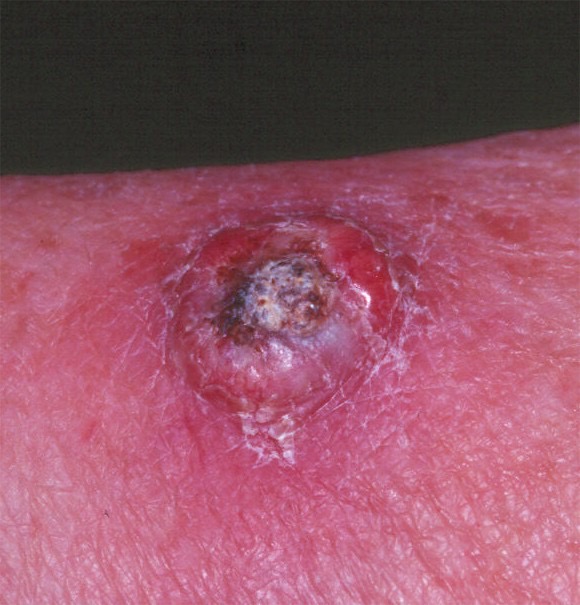
KERATOACANTHOMA
The keratoacanthoma (KA) is a rapidly growing tumor, usually of the sun-exposed skin that mimics a squamous cell carcinoma (SCC). In fact, the distinction between keratoacanthoma and squamous cell carcinoma, both clinically and histologically, is often difficult.
- The classic KA resolves spontaneously but rarely lesions may become huge by unrestricted growth.
- Chronic UV exposure is a predisposing factor and the patient should be examined for other nonmelanoma skin cancers. HPV DNA is found in a small percentage of lesions.
- Variants include multiple KAs of Grzybowski, of Ferguson-Smith as well and the vary large keratoacanthoma centrifugum marginatum.
A rapidly growing nodule that develops a central keratotic core in the sun-exposed area of an elderly person is characteristic. The hands and arms as well as the head and neck are commonly affected. The squamous cell carcinoma may present in a very similar manner as a red-white nodule, often with a hyperkeratotic core. As a rule, the SCC is slower growing than the KA--appearing over several months. Note that the basal cell carcinoma is usually pearly, translucent, and without any keratotic core.
Keratoacanthoma vs. Squamous Cell Carcinoma
Many studies have been performed to distinguish KA from SCC. Most of these rely on histologic criteria, although various immunohistochemical markers have been added to the toolbox. Unfortunately, many tumors still defy classification. Indeed, some even consider the keratoacanthoma a type of squamous cell carcinoma.
RegionalDerm
Homepage | Who is Dr. White? | Privacy Policy | FAQs | Use of Images | Contact Dr. White
It is not the intention of RegionalDerm.com to provide specific medical advice, diagnosis or treatment. RegionalDerm.com only intends to provide users with information regarding various medical conditions for educational purposes and will not provide specific medical advice. Information on RegionalDerm.com is not intended as a substitute for seeking medical treatment and you should always seek the advice of a qualified healthcare provider for diagnosis and for answers to your individual questions. Information contained on RegionalDerm.com should never cause you to disregard professional medical advice or delay seeking treatment. If you live in the United States and believe you are having a medical emergency call 911 immediately.
